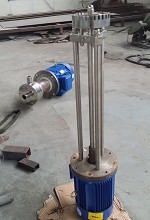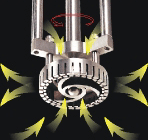Emulsifiers are also called high-shear emulsifiers, homogenizers, high-shear emulsifiers, etc. The emulsifiers are divided into: batch emulsifiers, pipeline emulsifiers (emulsion pumps), and emulsifiers that are connected to the motor. The high-speed rotation cuts, disperses, and impacts the material. In this way, the materials will become more delicate, promoting oil and water, gas and liquid, solid and liquid, and blending. Widely used in cosmetics, medicine, food, ink fine chemicals, petrochemicals and other products must be used emulsifier.
High-shear dispersion emulsification machine is a high-speed, stable rotation of the rotor, forming high-frequency, strong circumferential tangential velocity, angular velocity and other comprehensive kinetic energy efficiency; under the action of the stator, the stator and the rotor are formed in a narrow space with strong reciprocation. The combined effects of hydraulic shear, friction, centrifugal extrusion, liquid flow collision, etc., enable the material to circulate above the working process in the container, and ultimately obtain the desired product.
Intermittent high shear working process:
1. Under the centrifugal force generated by the rotor rotating at a high speed, the material is sucked into the working chamber from the up and down feed (two-way suction) area of the working head at the same time or sucked from the bottom of the working head (one-way suction).
2. The strong centrifugal force throws the material from the radial into the narrow precision gap between stator and rotor. At the same time by the centrifugal extrusion, impact and other forces, so that the initial dispersion of the material emulsification.
3. Produce a linear velocity of at least 15m/s or more at the outer end of the rotor rotating at a high speed, up to 40m/s, and form a strong mechanical and hydraulic shear, liquid layer friction, impact tear, so that the material is fully dispersed Emulsification, homogenization, crushing, and simultaneous ejection through the slots of the stator.
4. The material is continuously ejected from the radial direction at a high speed, and the flow direction is changed under the resistance of the material itself and the container wall. At the same time, under the effect of the upper and lower axial suction forces generated in the rotor area, the upper and lower strands are formed. Strong turbulence. After several cycles of material, the dispersion, emulsification and homogenization processes are finally completed.
Series equipment use: intermittent batch type, continuous pipeline type stable operation, low noise, easy to clean, flexible, can be used continuously, the material can be ultra-fine dispersion, emulsification. It can be widely used in emulsification, homogenization and dispersion in industrial production.
Emulsifiers have a wide range of applications, such as adhesives, paints, cosmetics, foods, pharmaceuticals, plastic resins, printing and dyeing, inks, asphalt, and other industries have a wide range of applications.
Fine chemicals: plastics, fillers, adhesives, resins, silicone oils, sealants, slurries, surfactants, carbon black, defoamers, brighteners, leather additives, coagulants, etc.
Petrochemical: heavy oil emulsification, diesel emulsification, lubricating oil, etc.
Daily chemicals: detergent, concentrated detergent, liquid detergent, various cosmetics, skin care products, etc.
Coating inks: Latex paints, interior and exterior wall paints, water-based oil paints, nano-coatings, paint additives, printing inks, printing inks, textile dyes, and pigments.
Bio-pharmaceuticals: sugar coatings, injections, antibiotics, protein dispersants, creams, health products, etc.
Pesticides and fertilizers: insecticides, herbicides, herbal emulsifiers, pesticide additives, fertilizers, etc.
Food industry: chocolate shell, fruit pulp, mustard, slag cake, salad dressing, soft drinks, mango juice, tomato pulp, sugar solution, food essence, additives and so on.
Nano-materials: nano-calcium carbonate, nano-coatings, various types of nano-materials additives, etc.
 
|


